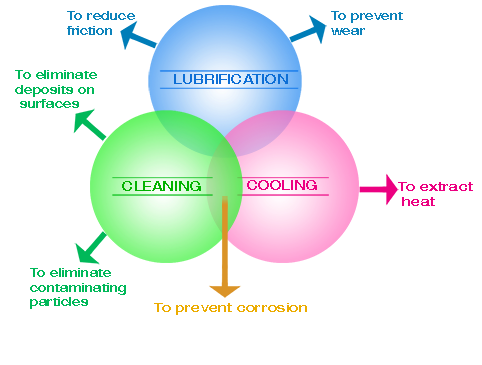LUBRICANTS FAQs
ROLE OF A LUBRICANT
Any vehicle owner knows that lubricants are vital to the correct operation of your engine; in particular they reduce wear.
But it also has other, less well-known functions:- Cools hot areas of an engine and moving parts.
- Reduces friction: A lubricant helps to improve engine efficiency and helps to reduce fuel consumption.
- Protects mechanical parts against wear and corrosion: guaranteeing long life and efficiency of the engine.
- Keeps the engine clean: It helps to guarantee long engine life and helps to keep all engine parts in a good and clean condition, while evacuating any impurities to the oil filter and through oil changes.
MOTOR OIL FAQs
ENGINE OIL VISCOSITY
Lubricants behave differently at high and low temperatures.An oil can, in effect, be characterised by its viscosity, its flow resistance or by the thickness of its oil film.
Viscosity varies according to temperature in the following way: the higher the temperature, the more fluid and less viscous the oil will be.
To ensure that your vehicle performs optimally, your oil should retain a certain level of viscosity in all weather conditions:It should remain fluid at low temperatures (to make cold starts easier) and viscous at high temperatures (in order to provide protection and sealing).
The grades that have been optimised for each of your oils are detailed in your service manual.
MOTORCYCLE OIL FAQs
WHY DO YOU NEED TO CHANGE YOUR MOTORCYCLE'S ENGINE OIL?
Engine oil has a tendency to lose its properties over time.
It should therefore be replaced on a regular basis in order to ensure that your engine lasts as long as possible.
Changing the oil is a straightforward operation that removes all the impurities from the engine.
There is, however, a technical aspect to it – choosing the right engine oil is essential. Consult our guide to find out which VIP lubricant is best suited to your motorcycle's engine.
COOLANT FAQs
ANTI-FREEZE TYPES
There are only 3 main types of anti-freeze:Green Anti-freeze:
These are the traditional type of anti-freeze most commonly used in North America. Their silicate and phosphate composition provides protection for aluminium and bare iron surfaces. They need to be changed every 30,000 miles or once every two to three years.
OAT (Organic Acid Technology) anti-freeze:These contain ingredients such as 2-EHA, sebacate and other various organic acids. Unlike green anti-freezes, they generally do not contain silicates or phosphates. Usually, OAT-based coolants will be dyed a different colour to green anti-freeze. They must be changed once every five years or 150,000 miles.
HOAT** (Hybrid OAT)** anti-freeze:These use organic acids but not 2-EHA and usually include silicates to provide protection for aluminium surfaces. HOAT anti-freezes are used by many European car manufacturers, although they are also used by American companies such as Chrysler and Ford. A HOAT coolant will need to be changed every five years or 150,000 miles. In recent years, anti-freeze manufacturers have been creating universal coolants that can be used with all vehicle types. These extended-life coolants only differ in colour. Some may be orange while others may be dyed blue or purple.
OIL POLLUTION & RECYCLING FAQs
HOW CAN WE PREVENT POLLUTION FROM AN OIL STORAGE TANK?
Any oil storage, such as tanks containing heating oil, diesel and waste oil, should be routinely checked and maintained to avoid the risk of causing pollution, through leaks and spills. For larger oil storage solutions on commercial sites, the tank may also need to comply with the Oil Storage Regulations.
It is always a good idea to keep your domestic heating oil tank in good condition, and ideally it should be properly bunded (contained within a sealed area or unit), so that in the event of a leak, the oil will not soak away into the ground.
This can cause a great deal of damage to your property and the wider environment and can be very costly to clean up.
As the owner you may be liable and even face prosecution if the oil pollutes groundwater or a nearby river. You may wish to check your home or business insurance policy to make sure you are covered for such incidents.

